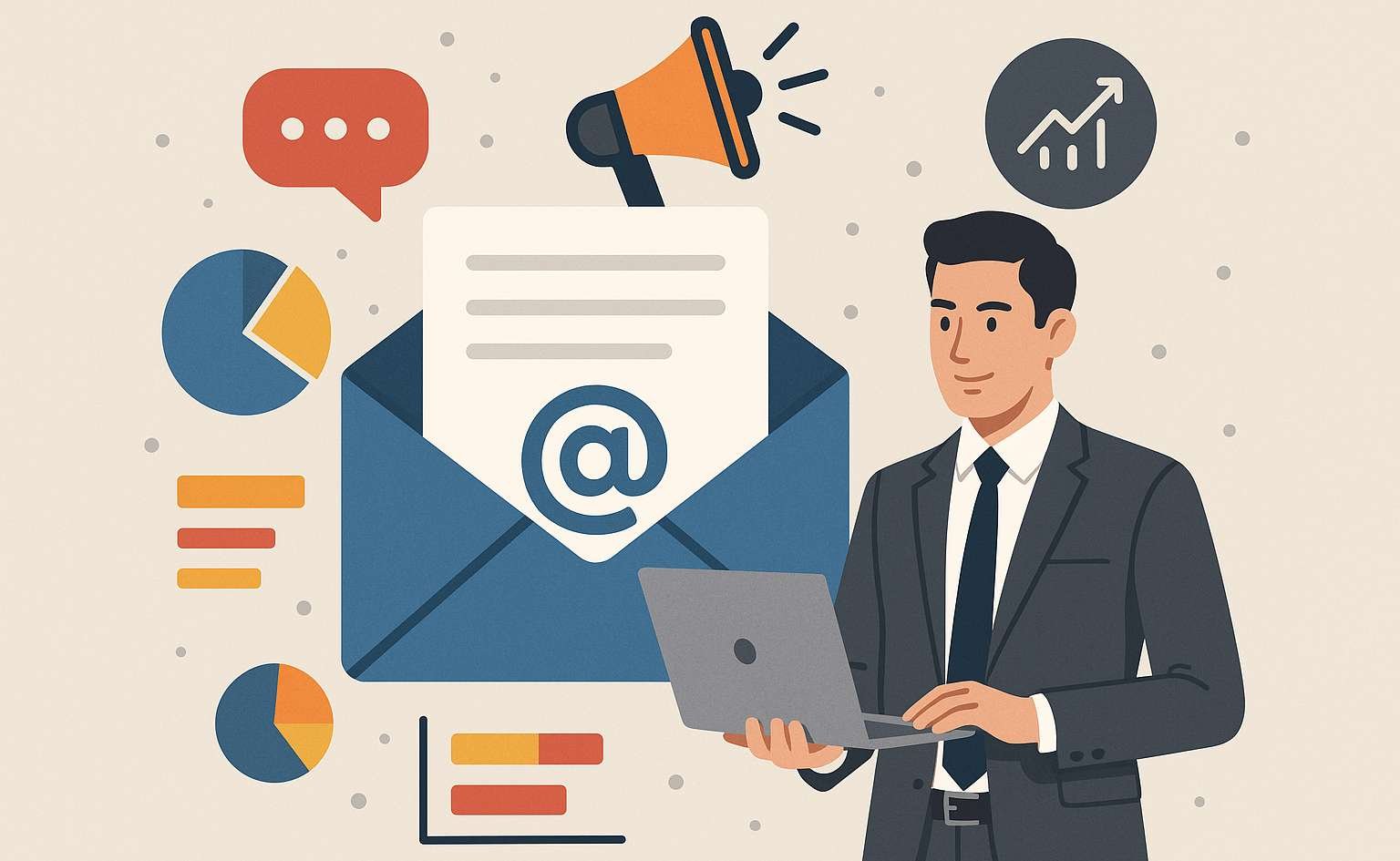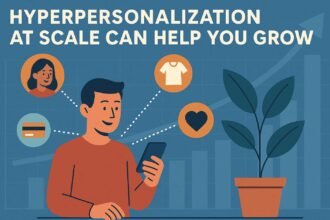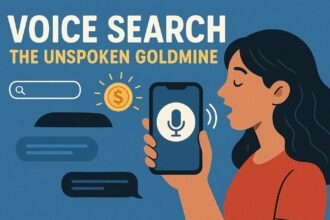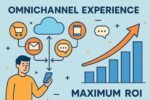Introduction to Email Marketing
Email marketing is a form of direct marketing that uses electronic mail as a means of communicating commercial messages to an audience. In its broadest sense, every e-mail sent to a potential or current customer could be considered e-mail marketing. It involves using e-mail to send advertisements, request business, or solicit sales or donations and is meant to build loyalty, trust, or brand awareness. Email marketing often involves using e-mail – not just to send copies of traditional or direct mail but also to enhance and build relationships with current or previous customers in ways that will affect future buying behavior.
Email marketing is the act of sending a commercial message, typically to a group of people, using email. In its broadest sense, every email sent to a potential or current customer could be considered email marketing. It usually involves using email to send advertisements, request business, or solicit sales or donations. It’s meant to build loyalty, trust, or brand awareness. Research shows that the strategy is one of the most cost-effective and efficient ways of promoting products or services. The term email marketing originates from the original form of direct mail; distinctively, it uses email as the primary delivery method rather than physical media.
Definition of Email Marketing
Email marketing is a digital marketing strategy that involves sending emails to prospects and customers. Effective marketing emails convert prospects into customers and turn one-time buyers into loyal, raving fans. Its history parallels that of digital communication strategies, and some definitions take a broader lens, encompassing various categories of marketing emails. Email marketing is fast, affordable, and a great way to reach people in their inbox. Because most business professionals check email multiple times a day, it’s easy to reach your audience on a platform they’re already actively engaged with.
There are many different types of marketing emails and a handful of ways to categorize them. Looking at content types, there are newsletters, promotional emails, and transactional emails. Under the larger umbrella of lifecycle or behavioral emails fall welcome emails, birthday or anniversary emails, re-engagement emails, cart abandonment emails, etc. Defining the different types of email not only helps build the right message and design, it also provides a clearer sense of how each category supports the business.
History of Email Marketing
Email marketing is a digital communication strategy that involves sending commercial messages to a group of people via electronic mail. It enables companies and organizations to connect directly with their customers and supporters, typically employing a well-designed, targeted email campaign.
The origins of email marketing date back to 1978, when Gary Thuerk, a sales manager for Digital Equipment Corporation, distributed the first bulk email advertising to 400 recipients. Despite causing controversy, this event led to $13 million in sales for DEC. The technique gained traction in the 1990s alongside the growth of web services such as Hotmail and Yahoo! Mail, which introduced new audiences to email. Today, email marketing remains a core activity for every email service provider (ESP).
Types of Email Marketing
Three main types of email marketing exist: newsletters, direct promotions, and transactional emails. Newsletters regularly provide subscribers with high-value content that informs and entertains, solidifying a relationship of trust while keeping the brand top-of-mind. They differ from promotional emails, which send subscribers limited-time sales and discounts to generate incremental business of greater volume or frequency. Objectively, promotions provide less value than newsletters, so many marketers sparingly send sales-focused emails to maintain their credibility and subscriber engagement. Transactional emails—also referred to as email receipts, confirmation emails, or triggered emails—are single sent during a specific stage of the subscriber lifecycle. They provide critical, ordered information and help reduce support ticket volume.
More sophisticated programs send lifecycle direct promotions designed to make a direct response and lifecycle newsletters created to build brand awareness and educate. These more evolved programs target consumers with more relevant information based on the number of times they have purchased a product or service. Triggered email marketing is a subset of transactional emails that lets marketers target customers with real-time messages based on their actions. Event-triggered emails differ from lifecycle emails by responding to a customer action that does not correspond with a specific lifecycle stage, like a recent product views showing or a web shopping cart abandonment.
Newsletters
Newsletters represent probably the oldest kind of email marketing. This is because the original commercial emailers simply resurrected the concept of a printed newsletter in an electronic form, an optimised form merely for transmission by email. The purpose of newsletters is to keep in touch: to tell customers what is going on, to maintain brand awareness and to develop brand loyalty. Newsletters can be used for a reader service, informing on industry trends, or simply as a reinforcement of the brand that people might have encountered elsewhere.
Typical content includes an article on a product launch, a news item of interest to the industry or about the customer themselves. However, the really important thing about a newsletter is consistency—getting a really well-produced newsletter out regularly, whether on a weekly, fortnightly, or monthly basis.
Promotional Emails
Promotional emails are designed to spark immediate action among customers. They target specific groups with tailored offers, aiming for prompt responses, as seen in limited-time shopping deals. This high operational intensity necessitates emailing quite frequently, sometimes multiple times each week.
The core objective of promotional emailing is to generate sales and deliver direct marketing results. From the brand perspective, customized pricing, timing, or content options help optimize gross margins or redirect product distribution. Messages may highlight price reductions, special offers, warranty programs, trade-in value, financing arrangements, or conveniences such as home delivery or free gift-wrapping. The emphasis continually shifts to fuel product demand by reminding and influencing customers.
Transactional Emails
The most transactional emails aren’t marketing at all—they include things like order confirmations, shipping notifications, renewing services, etc. These emails do have marketing messages in them, in the form of reminder, branding, or upselling—but they are necessary to complete the transaction, thank the customer, or confirm the relationship.
The open rate on transactional emails is generally very high, which makes perfect sense. The recipient actually wants to open them. They often have high click-through rates too, and so they’re great for cross-selling and upselling. For example, a shipping notification can feature a discount or confirmation of the recipient’s VIP status.
Lifecycle Emails
Lifecycle emails are sent based on a subscriber’s position in the sales cycle. The reasoning for sending lifecycle emails rests on the premise that people on different parts of the sales spectrum have different wants and needs and therefore respond better to targeted messages sent at a more strategic time. For example, a welcome message is non-relevant for a loyal customer but critical for brand new leads. Lifecycle emails may target a variety of specific points within the buyer cycle, including abandonment of a shopping cart or a “happy birthday” message in recognition of a subscriber’s special day.
Although sending conditional emails can be a complex process, the benefits of lifecycle emails are far-reaching. Nature Valley discovered that a targeted abandoned-cart email tailored to a user’s basket contents generated three times the sales compared to the generic follow-up message it had been sending prior to introducing lifecycle communications.
Event-triggered Emails
Event-triggered emails are part of lifecycle marketing but stand apart due to their focus on a specific activity or circumstance. They are automated to “fire off” a message after a predefined action, whether it is the subscriber’s action, an external event, or a set date or time. For example, an e-commerce retailer may send an email when a new item of interest to the subscriber is added to the catalogue or if there is a price reduction on an item left in the customer’s shopping basket. The main benefit of event-triggered emails lies in their high relevance and immediacy, factors that significantly boost engagement and conversion rates within email marketing programs.
Benefits of Email Marketing
A core advantage of many email marketing campaigns is their cost-effectiveness. Compared to other advertising platforms, the cost of communicating through email is almost negligible. Newsletters enable companies to compile monthly or bi-monthly publications revealing trends, new products or services, and promotions or events. These are inexpensive options to get customers interested. Promotional emails are usually cheaper to produce than product brochures, and the return on investment rates are considerably higher.
Emails also facilitate segmentation. The business can target customers according to age, supply preference, or other classifications, supporting a direct and focused message, which is significantly more effective than broad-based print or broadcast advertising. The results of these campaigns are measurable. The volume of incoming traffic from the email promotion or newsletter can be immediately recorded, easily identifying how successful the campaign was at generating traffic and interest. Transactional emails can inform customers when their orders have been acknowledged, shipped, delayed, or cancelled, keeping a customer updated on the status of their order. Lifecycle emails enable companies to keep in touch with customers on an ongoing basis beyond the initial transaction.
Cost-effectiveness
Cost-effectiveness is a leading selling point of email marketing. Without needing an extensive marketing team or a large budget, marketers have a channel to distribute relevant content, discounts, or personal messages to their clients and prospects. When compared to many other marketing channels, email marketing offers impressive ROI statistics. According to the Data & Marketing Association, email marketing provides an average return on investment of 4300%, which translates to $43 earned for every $1 spent. This considerable amount ensures the relevance of email marketing within the marketing mix and serves as a strong argument for continuously developing strategies that maintain the effectiveness of campaigns.
Email marketing allows the distribution of highly personalized messages, targeting different segments based on criteria such as buying intents, location, demographic data, and preferences. This segmentation converts the mass nature of email marketing into a highly relevant channel for transactional and lifecycle communications. Marketers can combine prospecting campaigns aimed at converting prospects with retention-oriented efforts and transactional emails. Through segmentation and match-code lists, each audience segment receives content aligned with its current standing in the customer lifecycle.
Targeted Messaging
Targeted messaging further increases the relevance of the communication for the recipients. In customer relationship management (CRM) a distinction is made between segmentation and personalization. Segmentation divides the list of recipient addresses into groups according to sociodemographic criteria, such as age, sex or place of residence (e.g. sending a newsletter about women’s fashions to the female subscribers only), or behavioural data, such as: Buying behaviour (e.g. sending a coupon for a specific product that a customer has just purchased), opening rate of emails (e.g. sending more regular emails to very active subscribers) or link clicks (e.g. sending information about a product about which a user clicked a lot in the newsletter). Segmentation allows improved targeting of an email marketing campaign but reaches the same recipients with identical messages.
Measurable Results
Brands can monitor the journey of a piece of content, measuring subscriber access to the content itself. These online me The most distinguishing feature of this channel is undoubtedly the measurement: marketing strategies can be analyzed, monitored and controlled in real time. In terms of measuring, marketers can tag digital content with monitoring codes and observe how recipients interact with the content itself.
They can determine the extent of the recipient’s engagement with an email by assessing whether the email was opened, if any links were clicked, and which links specifically generated traffic directed towards a landing page or product.
Increased Engagement
Email marketing allows a marketer to interact with audiences, whether by starting a conversation or continuing it. A well-planned email marketing campaign can be like a visit from an old friend—welcoming and pleasant. All five types of email marketing support ongoing dialog with recipients.
Lifecyle-email marketing uses email to keep in touch with customer, such-make customers feel wanted and needed. The context of the communication is perfectly clear: the business cares about you as their customer, and they want to stay in touch with you.
Brand Loyalty
The customer is the reason of existence for every company or business. Without customers, there would not be any business. Every business concentrates on getting new customers and retaining existing customers. Businesses spend more money on acquiring new customers than retaining existing customers. These days companies understand the cost of acquiring new customers and they converge towards retaining customers. Retaining customers is easier than acquiring customers. These days it is easy to switch products and services and get it at less cost. Companies need brand loyalty to prevent people from switching their brands to other brands.
Customer engagement, customer happiness, and customer satisfaction are helping companies develop loyalty for their brands. Loyalty is among the most important assets for growth and success of any company or business. It supports for sales, growth, and profits. Companies invest money to build loyalty among people. Organisations that keep their customers happy and satisfied concentrations on building trusting relationships with their customers. How customers have loyalty or belief in any company for services or products. Customer loyalty helps organisations to protect their customers from competitors. Customer commitment and belief towards any company or organisation for products or services keeps customers from switching.
Best Practices for Email Marketing
To unlock the full potential of email marketing, a strategic approach is essential. Successful email marketing begins with building a legitimate list of subscribers who have opted in to receive information. Employing the double opt-in method enhances the quality of the subscriber list by confirming the intent of subscribers and ensuring the accuracy of their email addresses. Segmentation creates smaller, well-defined groups of recipients, allowing marketers to tailor content and calls to action for maximum effectiveness. Tailored email marketing campaigns resonate more with recipients and increase the chances of achieving their objectives. Personalization at the individual level elevates engagement, with personalized emails demonstrating increased open and click-through rates.
A/B testing is a valuable tool for optimizing various elements of an email campaign—including subject lines, content, design, and timing—to determine what best resonates with the audience. The timing of email distribution is another critical factor; for instance, newsletters are often sent in the morning, while promotional emails targeting impulse buyers may be more effective in the early evening hours. Incorporating automated emails—such as transaction confirmations, appointment reminders, birthday greetings, and holiday offers—builds rapport, foster customer loyalty, and encourage repeat business.
Building a Subscriber List
Building a subscriber list is the initial step toward developing a successful email marketing campaign. Opt-in forms provide an accessible means for visitors to subscribe during the browsing process. Forms must be highly visible and simple to complete. When building an opt-in form, a major consideration is where to collect the subscriber’s details. The footer, sidebar, and contact page provide space for persistent forms, or a popup may be used to grab the visitor’s attention. Once the location of the form has been decided, the next step is to determine the content that it will hold, generally including the fields for name and email address, along with a subscribe submission button.
An alternative strategy is imitating never-ending opt-in forms, keeping interest alive with an offer of discounts, newsletters, freebies, and deals. This tactic is especially useful if there are multiple reasons to entice the customer to subscribe. The disadvantage lies in the potential annoyance caused by aggressive pop-ups. It’s also critical to understand the tripwire — the maximum number of opt-in pop-ups a visitor is prepared to tolerate. Incentives such as eBooks, online courses, or discounts play an effective role in encouraging newsletter subscriptions.
Segmentation Strategies
One of the main rules of successful email marketing is that the right message should reach the right people at the right time. To make this happen, customer data must be collected in the context of subscription management and carefully analysed so that customer groups can be created and served accordingly—and all of this is governed by data protection regulations. Because in the end it is only relevant recipients who open the newsletter and enter into communication with a brand. A business-to-customer (B2C) business selling mountain bikes might divide its target market in the following way:
– People who have never bought a mountain bike but are interested in the product – People who bought a mountain bike one to three years ago – People who bought a mountain bike more than three years ago – People who have subscribed as partners of the mountain bike business
The company thus differentiates in terms of previous customer behaviour, age and gender, interests and hobbies, and purchases or sales carried out. It then targets the individual groups with customised content and…makes an offer or call to action that always fits the segmentation and rules.
Personalization Techniques
Personalized addressing is achieved by changing the recipient’s name or any other characteristics in the header or salutation of an email. Modern email marketing tools provide the option to assign a list of contacts additional attributes. Using so-called merge tags, individual attributes for each recipient can be inserted anywhere in the email content, e.g., “Hi Sarah” (with the attribute “first name” being “Sarah”) or rendering coupons with different values for each customer.
Both concepts can be combined in one email campaign. For example, a user can be addressed by first name and location in the email header and salutation and be provided with a coupon code in the email content. For instance, Sarah from New York city could receive a special offer for the 4th of July, whereas John from Seattle could receive his offer for July 4th, emphasizing the importance of regional personalization.
A/B Testing
A/B testing involves sending two different versions of an email to randomly chosen segments of a contact list, where one variable—subject line, content, call to action, or image—is changed between versions. This method helps determine the more effective option by measuring recipient responses, such as open rates and click-through rates. Optimizing emails through A/B testing is an essential practice to enhance engagement and conversion rates.
Understanding what resonates with the audience is crucial for maximizing the effectiveness of email campaigns. A/B testing supports well-considered messaging choices, ensuring the right content reaches the right people at the right time. Conducting A/B tests in an organized manner increases the chances of email marketing success, helping marketers move beyond guesswork to data-driven decision making.
Timing and Frequency
Timing and frequency represent two of the most important variables in email marketing. As with many aspects of marketing, the intention is to strike the right balance between being present and annoying the recipient. Some marketers follow the approach of saturating the Inbox, under the assumption that it is better to be noticed and risk their emails being ignored or unsubscribed from, than not to be noticed at all. Others follow the opposite route, only sending highly relevant emails at longer intervals, so that engagement might be much higher, but where the risk of being forgotten might also be higher. Shorter intervals with highly relevant emails should support higher engagement and reduce the likelihood of unsubscribes, but not all marketers have sufficient data for such in-depth targeting.
Defining the right timing and frequency should, therefore, be based on the individual context of each marketer and adjusted using the results obtained from A/B testing.
Email Marketing Tools and Platforms
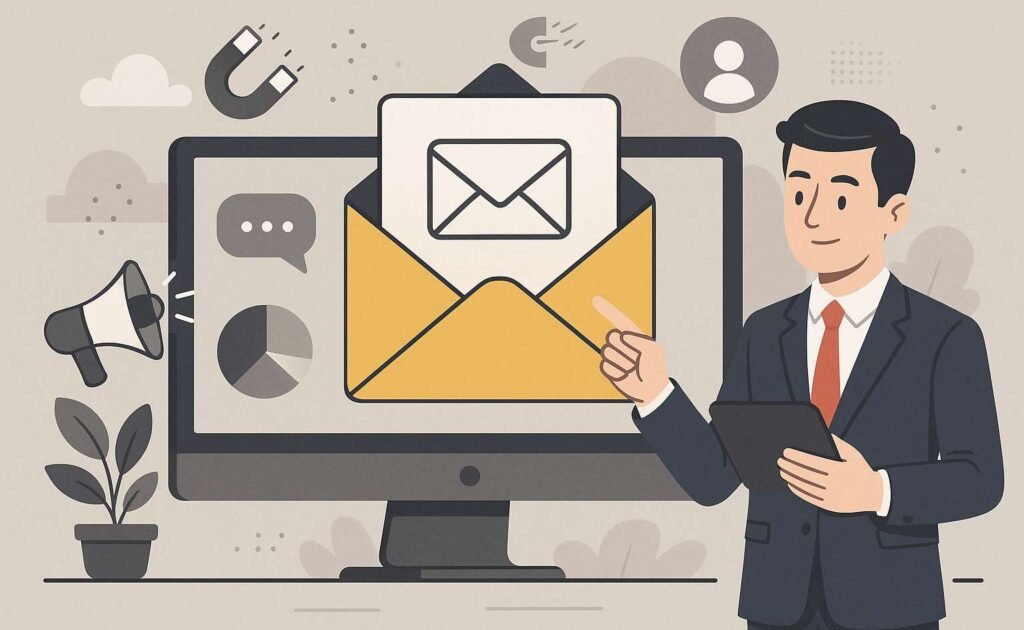
Various tools and platforms assist marketers in optimizing email campaigns. Email marketing service providers help build mailing lists; email marketing platforms allow the effective design of email marketing campaigns; email marketing automation tools support the implementation of emailing strategies; and analytics and reporting tools enable performance analysis.
Despite being an affordable option for many businesses, email marketing is associated with several challenges. Deliverability issues, such as emails landing in spam folders, demand constant attention. Furthermore, spam filters and corporate firewalls can degrade email quality before reaching users’ inboxes. The availability of low-cost alternatives compels marketers to intensify efforts to capture attention quickly. Enhancing campaign relevance and engagement is a key challenge, especially when users are exposed to multiple communications daily. Maintaining audience interest over time calls for strategies like optimizing send times, audience segmentation, and ongoing A/B testing—best practices supported by specialized tools.
Email Service Providers
Email Service Provider (ESP) platforms are a must-have for effective email marketing. They enable you to create, personalize, and optimize automated email campaigns. Designed for deliverability, ESPs ensure your emails land in subscribers’ inboxes for maximum impact. But ESPs are far more than basic email-creation tools.
A good ESP offers list-building features—like sign-up forms and popup banners to help you grow your list. Plus, segmentation features let you serve highly relevant content tailored to recipients’ interests. Bonza ESPs offer personalization dynamic content blocks, custom fields, and merge tags. Use A/B testing features to optimize subject lines and copy, and scheduling tools to find the perfect Send Day and Send Time. Advanced ESPs include automated emails, like abandoned cart notifications or birthday greetings.
Analytics is where ESPs really shine: that’s where you can measure open, click, and unsubscribe rates, plus monitor your email deliverability score. Understanding performance allows you to refine your email marketing strategy for even better engagement and conversions.
Automation Tools
Automation tools are popular with email marketers. They make a tedious job much easier and can often yield better results when compared with manually sending marketing emails. There are three distinct types of tools: email marketing service providers, email marketing automation and lifecycle marketing platforms, and analytics and email tracking tools.
Email marketing service providers have user-friendly email editors, subscriber list-management and segmenting features, and reporting tools. They make easy email marketing affordable.
Email marketing automation and lifecycle marketing platforms optimize the timing of emails based on subscriber behavior and attributes. Automation triggers include shopping cart abandonment, new subscriber welcome, next logical product recommendation, post-purchase promotions, completing registration, and other lifecycle events.
Analytics and email tracking tools integrate with your marketing platform and provide additional reporting data. They provide a holistic view of your marketing on all channels, including email marketing, and advanced attribution of revenue generated from that marketing.
Analytics and Reporting Tools
Analytics and reporting tools provide valuable insights into the performance of email marketing campaigns. By examining detailed reports, marketers can fine-tune their strategy and improve results. Deliverability, conversion rates, and engagement metrics can be monitored over time to highlight areas for improvement.
Email marketing platforms typically include integrated analytics and reporting functionality, though dedicated programs and tools are also available. Performance data usually encompasses the open rate, click-through rate, bounce rate, unsubscribe rate, and complaint rate of each campaign. From the raw data, metrics such as deliverability and conversion rate may be calculated. Email client reports and geographic information can reveal trends across different market segments and user groups.
Legal Considerations in Email Marketing
Email marketing is the sending of messages through electronic mail (also called “e-mail” or “email”). In its broadest sense, any marketing message sent via e-mail could be considered email marketing, even transaction-based messages, messages between business partners, or personal e-mails. A more precise definition is that “only electronic mail messages that include an advertisement or solicitation are considered commercial or marketing messages”. This restrictive definition excludes all transaction-based, relationship-based, or other non-advertisement messages.
The term “email marketing” may be used to refer to: sending e-mail messages to prospects and customers; e-mail lists used to send marketing messages; a solitary e-mail message sent to all or part of a mailing list; the sale of e-mail lists; or using e-mail services and software to send marketing messages. Transactional, relationship messages, and one-to-one messages are usually excluded from the definition, in which case every digital marketing communication other than one-to-one messages may be considered email marketing.
Most sources use the term in one of two ways: collectively to refer to all e-mails used for marketing purposes (including e-mails sent for any of the reasons listed above), or only to those commercial e-mails for which recipients have opted in to receive (i.e., those e-mails sent as part of permission marketing campaigns). The latter interpretation has become most common in the wake of recent anti-spam legislation, which aims to distinguish between legitimate marketing, for which a consumer’s consent has been given, and spam, for which it has not.
CAN-SPAM Act
CAN-SPAM is an acronym for Controlling the Assault of Non-Solicited Pornography and Marketing, a law that establishes requirements for commercial email, spelling out penalties for spammers. The Act requires sending commercial emails through the United States Postal Service and the Federal Trade Commission. The Act was signed into law by President George W. Bush on December 16, 2003, and business entities, as senders, must adhere to the regulations. CAN-SPAM also offers recipients the right to opt out of future emails from a sender by using an opt-out mechanism.
Failure to comply with CAN-SPAM can result in penalties of up to US $16,000, and the Federal Trade Commission actively pursues violators. The law defines messages with sexual content and graphics as pornography. Commercial emails must be clearly identified and labelled according to these guidelines, covering all forms of marketing, promotional materials, and solicitations.
GDPR Compliance
The General Data Protection Regulation, or GDPR, is another set of compliance requirements that USPS and most email marketers should keep in mind. It is a set of EU regulations meant to enable and protect privacy rights for all residents within the EU and the European Economic Area. Although it focuses on these geographic regions, many consider it appropriate to apply GDPR to any email marketing campaign in addition to the regulations of the specific geographic area in which a campaign’s audience resides.
GDPR does not regulate the content of the email message itself; it regulates the process of obtaining recipients’ consent to receive the grant of permission. When subscribers opt-in to receive an email campaign, any details recorded during that action must be verifiable by the sender. When an opt-in process used to captured subscriber information does not meet GDPR standards, a sender can violate those regulations. Compliance requires, at minimum, that: • Subscribes freely give their explicit consent. • They are made aware of exactly what information they are consenting to. • The sender can verify and prove the use of an opt-in process that meets these standards.
Challenges in Email Marketing
In spite of all the benefits of email marketing, businesses often face challenges with implementing it. Some of these challenges include deliverability and spam filters, which cause emails not to go into users’ inboxes. Furthermore, the open rate, click-through rate, unsubscribe rate, and timing of emails can present problems for companies.
Deliverability refers to the ability of an email to reach the subscriber’s inbox, yet spam filters can cause it to go to the junk folder instead. The open rate measures the number of people who actually open an email that has been sent. The click-through rate is the percentage of people who opened an email and clicked on at least one link within it. Conversely, the unsubscribe rate counts the number of recipients who opt out of receiving future emails. If emails are sent too frequently, people might unsubscribe; if they are sent too infrequently, people might forget that they signed up, thereby decreasing the effectiveness of open and click-through rates
Deliverability Issues
The effectiveness of an email marketing strategy depends largely on whether the emails actually reach the recipients’ inboxes. In this regard, deliverability should receive top priority at all stages of a campaign. The concern here is with the percentage of sent emails that land in the recipients’ inboxes, rather than being rejected as undeliverable or marked as spam. This pain point is influenced, among other things, by the quality of the mailing list and the complexity of the subject line.
Deliverability rates require constant monitoring to detect any drops in success. The quality of the email list is particularly crucial, since invalid or inactive addresses can prevent the delivery of messages, reduce click rates, and ultimately disappoint the sender. Mailing list hygiene refers to maintaining a clean list and carefully evaluating the recipients before trying to re-engage them.
Spam Filters
Spam filters serve as gatekeepers for email inboxes, helping users avoid unwanted and potentially harmful promotional messages. When you subscribe to a company’s newsletter or offers list, your email address is added to their main mailing list. However, multiple messages bombarding recipients’ inboxes daily can be overwhelming. Besides the users, email clients such as Gmail, Inbox, Apple Mail, Outlook, or Yahoo! also seek to control and manage this looming buildup of smart ads.
Out of this mounting need arose the spam filter. Also known as spam blocker or junk filter, these are programs designed to identify unsolicited or unwanted advertising materials. Operational on an email client level or integrated within company servers, spam filters remove incoming emails that meet predefined criteria for junk mail. Alongside spam filters are blacklists—Lists that help keep out broadcasting, malicious, or spammy material before it reaches the user’s inbox or the system’s email client.
Maintaining Engagement
Beyond striving for a high-quality email list, it is crucial to find ways to maintain subscribers’ engagement with campaigns over time. Regular, but not-too-frequent, contact is key; daily emails can cause an inundation effect, provoking unsubscribing, whereas monthly messaging can be so sparse that recipients forget they signed up and may not open a campaign for weeks or even months. Different subscribers also require varying levels of communication, as interest wanes or the buying cycle progresses.
To address this, lifecycle campaigns offer a strategy that adjusts to each subscriber’s current stage in the buying journey (engagement, nurturing, acquisition, or retention). Careful management of lifecycle emails is particularly effective for reducing unsubscribing rates, as communication frequency is personalized. The precise moment in the buying cycle at which each individual stands is ascertained by analyzing past data and previous subscriber activity, such as website visits, which can indicate brand engagement even in the absence of recent purchases.
Future Trends in Email Marketing
Email marketing has evolved substantially over the past two decades and is unlikely to slow down. Email marketing trends continue to grow, showing marketers the direction the landscape will take, helping them develop their strategies, set budgets, and choose the right technology. While it is impossible to predict the future with absolute certainty, current advancements in AI present exciting opportunities—and threats—for email marketing. Understanding and harnessing the potential of AI in email marketing is crucial for future success.
The email marketing landscape is heading toward greater personalization of the user experience, with enhanced targeting and technology integration. As inboxes become increasingly cluttered, piecing together the customer journey in real time remains an ongoing challenge. AI may offer a solution, enabling marketers to analyze browsing behaviors, weather conditions, time of day, local news, and more to craft targeted offers that resonate with individual recipients. When combined with automation platforms and CRM software, AI-generated coupons can be delivered right when they are most relevant. Despite the evolution of other platforms, email marketing remains a tough competitor. Studies show that a staggering 78% of consumers have unsubscribed from email lists due to excessive volume, underscoring the need for thoughtfully crafted and targeted communications.
AI and Automation
Artificial intelligence (AI) and automation are reshaping digital marketing throughout 2024. Major platforms such as Google Ads now incorporate AI and machine learning in performance-to-goal Smart Bidding and audience targeting. GPT-4 and ChatGPT support rapid ad creative copywriting. AI-enhanced advertising analyses will complement existing capabilities in Google Analytics 4. With AI development, automation features will become easier to adopt and implement. Marketers can expand expertise by testing AI-powered tools across Google and Meta advertising. AI and automation have a similar relationship in email marketing. Automation helps marketers deliver the right message at the right time by sending emails automatically based on specific triggers and customer activity. Moving a step further, AI can identify patterns in email marketing campaigns, forecast customer behavior, and recommend automated offers related to purchases often made by the customers’ peers.
AI and automation can reduce the email creation burden for marketers by drafting copy and generating images within minutes, eliminating writer’s block and speeding up the creative process. By optimizing send times and frequency per subscriber, marketers can avoid overwhelming customers and ensure emails land in inboxes when recipients are most likely to engage. To combat decreasing email deliverability rates, AI can cleanse marketing databases, identify recently active subscribers, and help marketers focus efforts where they are most effective. These technologies empower marketers to remove repetitive tasks from their workflows, retaining clients and gaining a competitive edge. Leveraging AI-powered automations enables companies to maintain fresh messaging and cost-effectively re-engage customers, fully capitalizing on the marketing potential of the email channel.
Interactive Emails
Interactive emails are enhanced with dynamic content that reacts to user actions, boosting engagement, conversions, and sales. They are well utilized in travel, e-commerce, and retail sectors. A primary form of online interaction involves facilitating purchases or bookings directly within the email; for instance, a travel brand might enable ticket booking without leaving the message, or a retail store could allow color variations of a product to be chosen. Surveys or polls may be embedded directly for immediate customer feedback, and forms can be completed inside the email for services like subscriptions, downloads, trials, or product registration.
Recent advancements include HTML5 form technologies that incorporate elements such as radio buttons, drop-down lists, text fields, date pickers, and interdependent lists. User actions trigger conditional content tags, enabling answers submitted inside the email to display context-sensitive, personalized content. Query and conditional tags continue to be employed within interactive emails, as exemplified by Andrew Kordek from TripAdvisor and Yuriy Kondratiuk from Mowingo.
Integration with Other Channels
Email marketing does not operate in a vacuum; it can and should be integrated with other marketing channels. Indeed, it is possible to combine emails with QR codes, URL links, or various social platforms (e.g., Facebook, Twitter, or LinkedIn). For example, services such as “MailChimp” allow one to create and send newsletters that are then shared across the most important social sites. Service providers have also developed software that includes Facebook buttons in emails that let users comment on them and recommend them to their friends on the platform.
This type of integration offers many advantages: linking e-mails to social sites creates a community of recipients who are likely to communicate amongst themselves as well. In addition, the viral effect of the Facebook messages amplifies the impact of the original marketing campaign. Similarly, QR codes or links to websites can stimulate recipients’ interest, allowing them to immediately seek further information or buy online.
Case Studies of Successful Email Marketing Campaigns
Email marketing is a tried and tested way of reaching out to potential customers. Sending an email is a cost-efficient way of reaching a large audience—even more so when considering how more and more people rely on smartphones and their iPads for their day-to-day communication. This helps reduce costs because one eureka moment can come from a short text message emailed at an ideal time.
The top five most significant benefits can be summarized as follows: 1) Low Cost—the cost of e-mail marketing is significantly less than traditional media; 2) Targeted Messages—it is easy to target customers based on demographics and previous behavior; 3) Measurable Results—clickthrough rates can generate real-time reports created by most Email Service Provider (ESP) software tools; 4) Increased Customer Engagement—monthly newsletters with industry information and details of new products and services, and 5) Increased Brand Awareness and Loyalty—recognition of products and services to encourage repeat business. Educational newsletters encompass a vast number of topics related to the needs of the subscribers, centering around their hobbies, businesses, and daily lives.
Conclusion
The preceding sections define email marketing as one of the most promising forms of digital marketing, described as turning business relationships into one-on-one communication on a global scale. Despite the advent of newer platforms such as Facebook, Twitter, and LinkedIn, email remains a highly efficient means of reaching target audiences, and addressing a slightly older demographic might be more advantageous in specific campaigns. Initially affected by its unreliable and intermittent nature, text-based email has since benefited from the development of email clients. These clients allow marketers to present e-mail communication in a clear and branded manner that prompts readers to take desired actions, including the utilization of processes like newsletters, promotional, transactional, lifecycle, and event-triggered emails.
The primary benefit of email marketing lies in the potential to contact an extensive audience at an economical rate. The real advantage of email marketing algorithms such as Lifecycle and Event-triggered email marketing is that they eliminate the guesswork and deliver specific messages at the correct time. Targeted messages result in higher open and engagement rates, and with proper account setup and maintenance, the performance of these campaigns can be quantified. Additional benefits encompass sending targeted messages to an engaged audience and achieving increased brand awareness and loyalty from clients.


